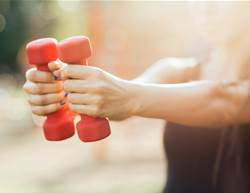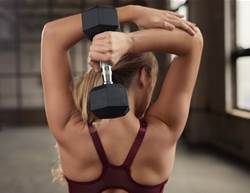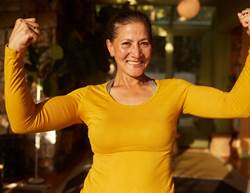Going to the gym and lifting weights is the last thing on many people’s mind. Even if you’re a fit, active person, resistance training can be daunting. But there are so many benefits, and it’s not hard to get started.
Benefits of weight training
Weight training is not about getting big “guns”. It’s about building and maintaining muscle over all your body, which is especially important as you get older. Imagine yourself at 70 – you want to be able to lift your groceries, play with your grandkids and get to social events, all without injuring yourself.
It includes the use of weight machines, exercise bands, hand-held weights, or our own body weight (such as push-ups, sit-ups or planking), reports The Conversation.
Conquering pickleball or walking every day are great forms of cardio exercise. But it’s also important to add resistance training or strength training into your workout routine. The Australian government recommends adults do muscle strengthening activities on at least two days each week.
The benefits of weight training include:
- Increased strength
- Improved endurance
- A more toned body
- Preserving and building lean muscle mass
- Improving your bone density
- Lowering your risk of injury and achy joints
- Building a stronger core and improving balance.
- Reducing the risk of chronic conditions such as diabetes, heart disease and depression.
- Improving posture

“All of these benefits are important as they play a role in our daily activities, in addition to our workouts,” says personal trainer Maricris Lapaix (pictured above), from fitness program Centr.
“With a sedentary lifestyle, it is more common to experience injury with everyday activities such as lifting moving boxes, or fatigue walking up a flight of stairs, for example.”
She adds that resistance training can not only make you feel great, but also slow down the ageing process.
“Weight training is important for all ages because it enhances quality of life. If one doesn’t train regularly, to put it in layman’s terms: ‘If you don’t use it, you lose it.’
“Youth and young adults may not feel the effects right away, however, middle-aged adults can begin to feel the negative effects like bad posture, body aches, lack of energy and strength, as well as emotional effects like lack of confidence, or even poor mood.
“The effort that you put into your fitness care, and health and wellness routine, truly becomes the determining factor of how old you feel, as well as how you experience your day-to-day activities.”
Can anyone do strength training at home?
Lapaix says yes, we can do weight training at home. While you might like the social aspects of a gym, nothing beats the convenience of being able to work out when it suits you, without the commute.
People now know they can “keep their fitness routine going at home, or even get started for the very first time. Whether someone is able to dedicate an entire space to creating a home gym, or they have to use a smaller space in their living room, for example, weight training at home is accessible to everyone.”
If you need guidance, you may want to meet with a personal trainer to get your own tailored home workout program, or you might want to use a fitness app on your phone.
Is it safe to do weight training at home?
Talk to your doctor before you start any new exercise. And if you’re good to go, start with a light weight and build up slowly.
“One of the main concerns with the safety of weight training involves using equipment without proper form. This type of use could lead to potential injury,” says Lapaix.
“My biggest tip as a trainer is to pick a weight that allows you to move with control to reach the goal of the exercise. As you’re completing your reps, if you find that the last 2-3 reps begin to feel challenging, but you can still move with control, you’re in the right weight range.
“If you feel like you’re starting to recruit other muscle groups, you should consider moving down in weight. There is a better chance of workout routine adherence by progressing at a steady rate of progressive overload versus lifting heavily in the early stages of beginning a workout routine.”
Your beginner strength training program
Lapaix shares six simple resistance training moves for a beginner at-home program.
1. Dead bug
The is great for finding true core connection. Make sure your lower back is flush to the mat. Start with arms aligned with chest and knees table top position. Then extend opposite arm and leg until arm aligns with the ear, and leg just before the heel touches the ground. Add one dumbbell for load, if you feel ready.
Want to level up? Hold the table top position with dumbbell in one hand, and then extend the arm and leg on the same side.
2. Glute bridge
Place feet hip width apart, with toes and heels pointed straight ahead. Make your lower back flush to the mat, then push through the heels extending hips up. Squeeze the core and the glutes and the top. Lower back to the starting position with glutes touching the mat, or keep hovering just above the mat and return to the end range of the movement. Add a dumbbells for load, if you feel ready.
3. Squat to calf raise
This can be performed standing or in a chair. Stand with your feet hip-width apart, and dumbbells by side. Lower hips and if sitting in a chair to a 90 degree angle, or just past the knees, then push through the heels while bracing the core. Once at the top position, raise heels for the calf raise and repeat. (last exercise in video
4. Split squat
Stand with feet hip width apart. Then move one leg back to allow back knee to drop down creating a 90-degree angle. Make sure feet a positioned like they are on train tracks versus tight rope to ensure balance in this movement. Use a chair or wall for assistance with stability, if needed.
5. Bicep curl & press
Start with dumbbells by side. Curl up and then rotate into the press. During the press brace the core and keep from arching the low back. Press dumbbells up so that arms are aligned with the ears.
6. Bird dog row
Start in table top position, extend one leg out, and hold a single dumbbell in the hand of the opposite side. Draw bellybutton into spine and brace core. Once in a stable position, row the dumbbell back, engaging the upper back, then steadily return dumbbell to starting position.
“Depending on your fitness level, all of these exercises could be integrated into a weekly routine or be used as a simple workout routine. It could be done as little as two times per week, depending on your entire workout program,” says Lapaix.
“A good rep range for a beginner/intermediate person is between 12-14 reps per exercise, or also for time with 30-45 seconds of work (per side if it’s a unilateral exercise), with 15-20 seconds of rest, or as needed.”


.jpg&h=90&w=90&c=1&s=1)







